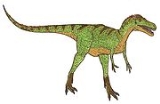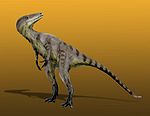
Xiongguanlong
Encyclopedia
Xiongguanlong is a genus
of tyrannosauroid dinosaur
that lived in the Early Cretaceous
of what is now China
. The type species
is X. baimoensis, described online in 2009 by a group of researchers from China and the United States, and formally published in January 2010
. The genus name refers to the city of Jiayuguan, a city in northwestern China. The specific name is derived from bai mo, "white ghost", after the "white ghost castle", a rock formation near the fossil site. The fossils include a skull
, vertebrae
, a right ilium
and the right femur
. The rocks it was found in are from the Aptian
to Albian
stages of the Cretaceous, between 125 and 100 million years ago.
 Xiongguanlong was a bipedal animal which balanced its body with a long tail, like most other theropods. It was intermediate in size between earlier tyrannosauroids from the Barremian
Xiongguanlong was a bipedal animal which balanced its body with a long tail, like most other theropods. It was intermediate in size between earlier tyrannosauroids from the Barremian
and later tyrannosaurids from the Late Cretaceous, such as Tyrannosaurus
, and has been estimated to weigh about 300 kilograms (661.4 lb). The vertebrae were more robust than in other basal
tyrannosauroids, possibly to better support a big skull. The skull had a long muzzle resembling that of Alioramus
.
, being the sister taxon
of a clade
consisting of Appalachiosaurus
and the Tyrannosauridae
.
Genus
In biology, a genus is a low-level taxonomic rank used in the biological classification of living and fossil organisms, which is an example of definition by genus and differentia...
of tyrannosauroid dinosaur
Dinosaur
Dinosaurs are a diverse group of animals of the clade and superorder Dinosauria. They were the dominant terrestrial vertebrates for over 160 million years, from the late Triassic period until the end of the Cretaceous , when the Cretaceous–Paleogene extinction event led to the extinction of...
that lived in the Early Cretaceous
Early Cretaceous
The Early Cretaceous or the Lower Cretaceous , is the earlier or lower of the two major divisions of the Cretaceous...
of what is now China
China
Chinese civilization may refer to:* China for more general discussion of the country.* Chinese culture* Greater China, the transnational community of ethnic Chinese.* History of China* Sinosphere, the area historically affected by Chinese culture...
. The type species
Type species
In biological nomenclature, a type species is both a concept and a practical system which is used in the classification and nomenclature of animals and plants. The value of a "type species" lies in the fact that it makes clear what is meant by a particular genus name. A type species is the species...
is X. baimoensis, described online in 2009 by a group of researchers from China and the United States, and formally published in January 2010
2010 in paleontology
-Anomalocaridids:-Newly named crustaceans:-Newly named insects:* A new family, Cascopleciidae, is published by Poinar Jr.* A new family of ceraphronoid Hymenopters, Radiophronidae, is published by Ortega-Blanco, Rasnitsyn, and Delclòs....
. The genus name refers to the city of Jiayuguan, a city in northwestern China. The specific name is derived from bai mo, "white ghost", after the "white ghost castle", a rock formation near the fossil site. The fossils include a skull
Skull
The skull is a bony structure in the head of many animals that supports the structures of the face and forms a cavity for the brain.The skull is composed of two parts: the cranium and the mandible. A skull without a mandible is only a cranium. Animals that have skulls are called craniates...
, vertebrae
Vertebral column
In human anatomy, the vertebral column is a column usually consisting of 24 articulating vertebrae, and 9 fused vertebrae in the sacrum and the coccyx. It is situated in the dorsal aspect of the torso, separated by intervertebral discs...
, a right ilium
Ilium (bone)
The ilium is the uppermost and largest bone of the pelvis, and appears in most vertebrates including mammals and birds, but not bony fish. All reptiles have an ilium except snakes, although some snake species have a tiny bone which is considered to be an ilium.The name comes from the Latin ,...
and the right femur
Femur
The femur , or thigh bone, is the most proximal bone of the leg in tetrapod vertebrates capable of walking or jumping, such as most land mammals, birds, many reptiles such as lizards, and amphibians such as frogs. In vertebrates with four legs such as dogs and horses, the femur is found only in...
. The rocks it was found in are from the Aptian
Aptian
The Aptian is an age in the geologic timescale or a stage in the stratigraphic column. It is a subdivision of the Early or Lower Cretaceous epoch or series and encompasses the time from 125.0 ± 1.0 Ma to 112.0 ± 1.0 Ma , approximately...
to Albian
Albian
The Albian is both an age of the geologic timescale and a stage in the stratigraphic column. It is the youngest or uppermost subdivision of the Early/Lower Cretaceous epoch/series. Its approximate time range is 112.0 ± 1.0 Ma to 99.6 ± 0.9 Ma...
stages of the Cretaceous, between 125 and 100 million years ago.
Description

Barremian
The Barremian is an age in the geologic timescale between 130.0 ± 1.5 Ma and 125.0 ± 1.0 Ma). It is a subdivision of the Early Cretaceous epoch...
and later tyrannosaurids from the Late Cretaceous, such as Tyrannosaurus
Tyrannosaurus
Tyrannosaurus meaning "tyrant," and sauros meaning "lizard") is a genus of coelurosaurian theropod dinosaur. The species Tyrannosaurus rex , commonly abbreviated to T. rex, is a fixture in popular culture. It lived throughout what is now western North America, with a much wider range than other...
, and has been estimated to weigh about 300 kilograms (661.4 lb). The vertebrae were more robust than in other basal
Basal (phylogenetics)
In phylogenetics, a basal clade is the earliest clade to branch in a larger clade; it appears at the base of a cladogram.A basal group forms an outgroup to the rest of the clade, such as in the following example:...
tyrannosauroids, possibly to better support a big skull. The skull had a long muzzle resembling that of Alioramus
Alioramus
Alioramus is a genus of tyrannosaurid theropod dinosaur from the Late Cretaceous period of Asia. The type A. remotus, is known from a partial skull and three metatarsals recovered from Mongolian sediments which were deposited in a humid floodplain between 70 and 65 million years ago. These...
.
Phylogeny
The describers concluded that Xiongguanlong split off from the main branch of the Tyrannosauroidea before AppalachiosaurusAppalachiosaurus
Appalachiosaurus is a genus of tyrannosauroid theropod dinosaur from the Late Cretaceous Period of eastern North America. Like almost all theropods, it was a bipedal predator. Only a juvenile skeleton has been found, representing an animal over 7 meters long and weighing over...
, being the sister taxon
Taxon
|thumb|270px|[[African elephants]] form a widely-accepted taxon, the [[genus]] LoxodontaA taxon is a group of organisms, which a taxonomist adjudges to be a unit. Usually a taxon is given a name and a rank, although neither is a requirement...
of a clade
Clade
A clade is a group consisting of a species and all its descendants. In the terms of biological systematics, a clade is a single "branch" on the "tree of life". The idea that such a "natural group" of organisms should be grouped together and given a taxonomic name is central to biological...
consisting of Appalachiosaurus
Appalachiosaurus
Appalachiosaurus is a genus of tyrannosauroid theropod dinosaur from the Late Cretaceous Period of eastern North America. Like almost all theropods, it was a bipedal predator. Only a juvenile skeleton has been found, representing an animal over 7 meters long and weighing over...
and the Tyrannosauridae
Tyrannosauridae
Tyrannosauridae is a family of coelurosaurian theropod dinosaurs which comprises two subfamilies containing up to six genera, including the eponymous Tyrannosaurus. The exact number of genera is controversial, with some experts recognizing as few as three...
.
External links
- "Ancestor of T rex found in China" BBC News
- "Fossil evidence of a goldilocks tyrannosaur" ScienceNews.org

